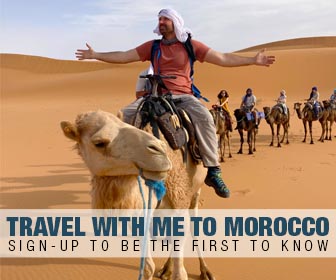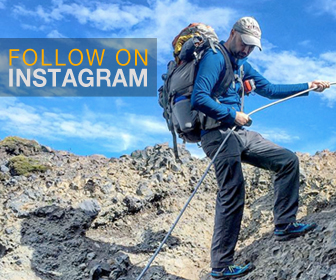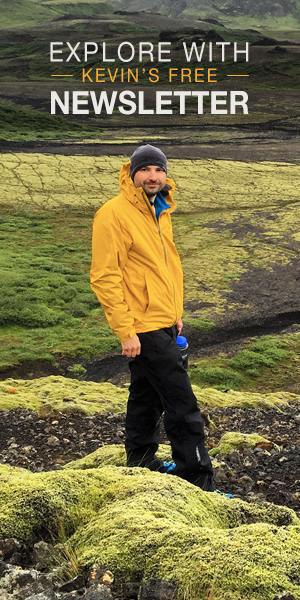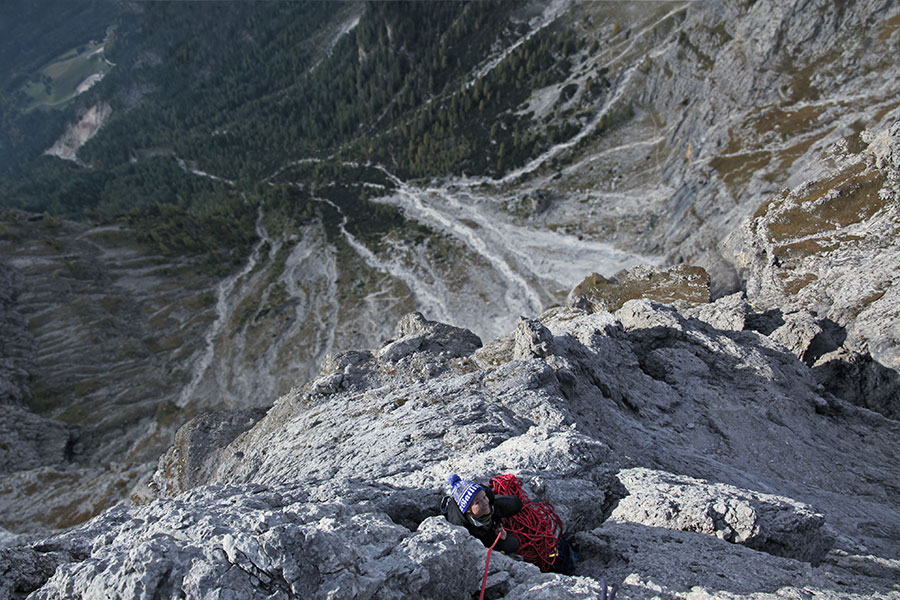
Planning an international climbing trip might sound like a daunting challenge, but if you follow these steps, you will find it a little easier and things will go smoother during your trip.
DECIDE ON A COUNTRY OF CHOICE
This might sound easy, but there are 195 countries with a lot of rock! If you want big wall climbing, there are lots of great routes in the alps that extend from France through Slovenia. If you love bouldering, you will find a lot more options around the world. Know what you are looking for and decide where you want to go. From Indonesia to North Macedonia to Jordon to Norway to Iceland, there are amazing places to climb.
FIND A CRAG AND A ROUTE OR BOULDERING PROBLEMS
Once you know where you want to go, locate the crag, or crags, you want to climb in. For example, I decided I want to climb in Norway. I chose the northern part above the arctic circle, researched climbing routes on blogs, looked at photos on Instagram, talked to friends that have been in that region, and found the routes I want to climb. On Instagram, I keep a saved folder called, “places to climb” for inspiration and also a folder for each country. When I see a great crag or route, I save the photo to those folders for reference and research later. When I am ready, I select the geo tag of that crag, read what others are saying about it, and sometime message users for information or more details.
I sometimes buy climbing guides for the area that lists every crag or every route with detailed descriptions. Instead of taking the book with me, I make a photo copy the one or two pages I need and carry those with me. Sometimes I order small laminated topo maps of the route so I can clip on my harness. Those are handy to know which direction to go on a non-bolted wall and the distance to the next anchor.
FIND A CLIMBING PARTNER
Finding a partner for your local crag is easy. It is much harder to find someone willing to travel internationally, have available days off work, enough money saved to pay for it, climbs at the level you are willing to climb, and is available during your schedule and when flights are cheaper. I mention the possibility of climbing internationally to a lot of people and plant small seeds in their heads. I sometimes get a call a year or more later from a friend wanting to go. By that time, they have saved enough money, built enough days off, is in a better place at work, or just decided to be brave enough to finally do it. If you plant enough seeds, something will eventually grow! The girl in the main photo, Toni, called me almost 1-year after we first talked about a climbing trip.
It helps to have multiple people planning to make the trip because one or more climbers may drop out because of a new job, issues at work or home, illness, or a variety of reasons. We had two others committed to the trip in the photo, but they dropped out. One more thing to consider is the thought of spending a week or two with that person non-stop in a confined space. People are often at their worst when they travel. Make sure you like each other well enough to spend that amount of time together.
RESEARCH LANGUAGE AND KEYWORDS
One of the hardest parts of researching is the language barrier. For example, if you are searching for a location near a hut, you should be using “Rifugio” in Italy or “Refuge” in France instead of the word hut. You will find a lot more information that way. Knowing these keywords will make understanding directions to the crag, climbing terms, and other aspects easier to research and understand. Once you find the information, you can use translation software, like Google Translate, to understand everything.
LEARN ABOUT THE CRAG/ROUTE(S) IN YOUR LANGUAGE AND THEIR LANGUAGE
Sometimes routes have different names in different languages. Just like China is spelled “中國” in Chinese, Italy is spelled “Italia” in Italian, and Victory Falls is called “Mosi-oa-Tunya” in Africa, climbing routes often have different names. If you only search for one of the names used for the route, you will only get answers from one viewpoint and maybe not the best one. I find if you use the name of the crag and route used by that country, you will find more information. Another issue with only one viewpoint is the variation in grade rating and quality. Some cultures vary on the class a scramble or route grade might be. What you consider a Class V rock climb might be a class III scramble to that culture.
To find a possible different name for a route/problem, use climbing websites and discussion pages to research. Mountain Project will often include the name of the route in its description or add an “aka” to the main title name. Even if you find a website that cannot be converted to English, use a translator like Google Translate to convert the information for you. Some climbing guides will list information in multiple languages and show all names for the route.
RESEARCH, RESEARCH, RESEARCH
You started this from above, but keep doing it. Read everything you can about the area, order guide books, talk to friends, message people on Instagram, and more. Never stop learning!
GET MULTIPLE SOURCES, NEVER FULLY TRUST THEM, AND BE PREPARED
One time I looked at a map of a 2-day backpacking trail that showed a river by the entire trail. I also read about 30 or more reviews of the trail. ALL of those reviews said water is available the entire trail and you don’t have to carry any. I looked at the trail on a map and noticed the river appeared to be below the trail at a lot of places, if not the entire trail. Before starting on the trail, I filtered water and filled every bottle and bladder I had. I am glad I did. Not only is the river about 100-feet below the trail the entire way, every person I met on the trail asked if I had water because they were extremely dehydrated! They too read the same reviews from writers claiming to have been on the trail, but clearly had not. There are a lot of copy and paste reviews with bad information out there. Writers and bloggers make assumptions when they see a map with a river beside the trail and assume it is on the same level, especially if they read other reviews that say the same thing. Other times reviews say water is available at two creeks on the approach, but both creeks are dry when you arrive. Sometimes anchors are sketchy when they are not supposed to be. Always be prepared for things to not be as you were told. This goes for backpacking, climbing, kayaking, and every sport.
Make sure to ask users on discussion pages about the route and message other climbers you see on Instagram about it. Make sure to ask questions about the security of the anchors. I find people are almost always willing to help! Many times I get information I wouldn’t have thought to ask or even expect!
FIND LOCAL LAWS
This isn’t just for international climbing trips, this goes for every new crag you visit. Can you top out on a route at that crag? Can you lower through the rings? Are you required to rappel? Is there a ban on the number of climbers per day? Is there a ban on the number of people on the approach trail? Are you required to register with someone? There are so many different laws that vary from crag to crag and country to country. Make sure you read detailed descriptions of the area that lists any laws you might need to know about. Most websites, like Mountain Project, will give a link to the information you need.
UNDERSTAND HOW THE AREA WILL AFFECT YOU, YOUR PARTNER, AND YOUR CLIMBING
You can climb all day at the elevation you live in, so you think you will climb the same level somewhere else. The problem is, you might get affected by things like altitude, lack of humidity causing dehydration, too much humidity draining your energy, or jet lag. Unless you know how your body reacts in that type of environment, you can’t assume you will climb at the same level or feel the same way. I often have subjects struggle to adjust to altitude and/or have jet lag once we get on the wall.
Make plans that do not include climbing your hardest grade until you know how you would be affected by the environment there. On the flight, and once you get there, drink lots of water. That will help ease the symptoms of most of these issues.
GET ADJUSTED TO LOCAL TIME BEFORE YOU GO
The general “that’s what they say” rule for time change is it will take one day to adjust to every hour the time is different. With that calculation, if you fly from the East Coast of the United States to Europe with a 6-hour difference, it would take 6-days to adjust to time in Europe. That means you are more likely to have jet lag and struggle while climbing until you are there for almost a week. Think about how would you feel getting up at midnight, climbing all day, then going to bed at 4 p.m. that evening. If that doesn’t sound like you would be at your best, you would not be at your best climbing there either.
I begin adjusting about 3-weeks before a trip. Instead of getting up at 6 a.m. each morning, I get up earlier and earlier each day until I am getting up at Midnight the final week before an international climbing trip. I sleep on the flight into the country during their night and when I land in a place like Europe in the early morning, I am adjusted, ready to go, and feel good. Sometimes my subjects adjust to this schedule with me, other times they don’t. When they don’t, they want to sleep all day and always struggle when climbing. Trust me, getting up 30-minutes earlier each day or two is much easier than 6-hours earlier one day and trying to rock climb all day.
DOUBLE CHECK PERMITS
Just because you read on multiple website that all you have to do is stop by an office to get a climbing permit doesn’t mean they are telling you the entire story or they even know the entire story. I have been turned away from multiple trips from climbing to horseback riding to fly fishing to rafting because the number of permits allowed per year were maxed out. I’ve had to move to a different crag because it still had permits left. If you are not prepared, you would have to wait until January 1 to climb at your chosen crag. It will help researching things like the number of permits allowed each year on the crag governing body’s website. Most climbers and writers might climb in early summer and do not even know about the limiting of permits.
Another issue with permits deals with deadlines. Sometimes, you need to apply for a permit far in advance. Other times you have to enter into a lottery. Even though the lottery is for a certain year, you might only have a couple days of the year to apply. I have alarms set on my phone to let me know to apply for certain climbing, hiking, or backcounty permits.
KNOW THE FEES
I’ve once followed a website written the month I traveled on that listed a permit fee as half what the actual fee was. Not only that, it had risen multiple times during the years since it was that cost. Always double check the cost on the actual governing body’s website. As I mentioned before, a lot of writers like to copy and paste info! You can look at the fees when you check the number of permits allowed!
LEARN ABOUT HIDDEN COSTS
Just because you read on an official website, “no permit fee or cost” and “no park entrance fee” doesn’t mean they do not have hidden costs. For example, I visited one “no-permit” crag with “no entry fees” into the park, but there was a $30 toll on the only road in and out of the area. I use the website ViaMichelin.com that shows the cost of each toll I would pass through. That is where I discovered the $30 fee while planning the trip.
MAKE A PLAN B AND PLAN C
I can’t count the times I have been delayed or rerouted because of road construction, land slides, road closures, or other issues. I have also been rerouted because of trail closures for various reasons. You need to know every way to reach the region, the crag, the approach trail, and the route. Once time the road in Italy was closed and a sign said the city council voted to close it earlier that day. At that point, the closure had not been submitted to Apple maps, Google maps, or any map service to redirect. There was no warning for that closure until I was at the road closed sign. Fortunately, I had researched other trails to get to the crag and knew where to go. We backtracked and hiked several extra hours to get to the crag.
Make sure you have other options available. Sometimes rain or ice will make a route or crag unclimbable. In this case, I usually have backup routes, and backups to those! I often plan a combined climbing and backpacking or kayaking trip where I drive a loop from my arriving airport. I plan the climbing part of the trip first because if there is an issue for weather, or anything else, I can always backpack or kayak first and climb at the end of the trip. If you chose to climb at the end, you do not have that flexibility and might miss the climbing portion of your trip.
When I travel to multiple counties with trains and flights during the trip, I plan that transportation in the middle of the trip for flexibility. For example, on the trip where the main photo on this page was taken, I drove counter clockwise from Munich to climbing in Italy, then took a flight from Italy to Greece and back, then through Croatia, into Slovenia for kayaking, and circle back into Munich. If the weather, or anything else, stopped me from climbing at the start of the trip, we could have went clockwise to kayak in Slovenia, continued on to Cratia, then the flight from Italy to and from Greece, and climbed at the end of trip without affecting our pre-booked flight to Greece.
RESEARCH BEST FLIGHTS TO GET THERE
Just like in the United States, the cost of flights to airports vary greatly. You might find a roundtrip flight to Paris from New York for $250 and one to a smaller airport for $1,000. In this case, look regionally. For the trip the main photo was taken on, I chose to fly into Munich, Germany instead of Milan because it was cheaper and it didn’t add a lot of distance or time. I subscribe to the pay portion of Scott’s Cheap Flights that tracks international airline deals. When a deal came available, like Knoxville to Munich for about $400, I jumped on it!
One hack is the fly into cheap airports and take cheap flights from European carriers from there. For example, my flight from Venice, Italy to Athens, Greece after climbing was only $9 on Volotea! You might consider flying into somewhere like Paris, or other cheap airports, and taking a cheap flight from there to your destination. Just make sure you are arriving and departing from the same airport. Paris has three airports in the area. Paris-Charles De Gaulle (CDG) is the main airport with the international flights, but some airlines, like Ryan Air, fly from a different airports.
MANAGE YOUR BACKPACK WEIGHT
Make sure you know how much weight your airline allows for checked bags. Then, make sure it’s the same weight on the way back! Many climbers fly out of the U.S. with a 50lb checked bag and get charged excess fees on the flight back because of laws in that country. This information is easy enough to find on the airline’s website.
If you are planning to climb with trad gear and ropes, you will have a heavy pack. Plan everything else very carefully! I usually have to leave something at home that I would normally carry to meet weight requirements. On the trip featured in my main photo for this page, I had a 48lb backpack that was mostly climbing gear!
UNDERSTAND WHAT YOU CAN CARRY ONTO A FLIGHT AND INTO A COUNTRY
Just because something isn’t illegal where you live, doesn’t mean it’s legal in another country. For example, quickdraws are illegal to carry onto a flight in some counties! Never try to carry your nut tool with you. On a security screen it looks like a knife and it’s hard to explain to a non-climber at airport security. Even if they don’t confiscate it, you will go through a long process of screening, explaining, and showing its use on YouTube to a lot of people.
Knives have a lot of uses when you are in the backcountry, but a lot of counties ban them from entering the country even in checked bags. I love my Benchmade knife for backpacking, but I rarely get to carry it on an international trip. One time I bought a cheap knive in a region I landed in and gave it to someone before I left. It was passible to open dehydrated meals, slice cheese, and what I needed it for.
To make it simple, put all your climbing gear in a checked bag and save yourself a lot of headache. Trying to explain a climbing cam to customs isn’t easy.
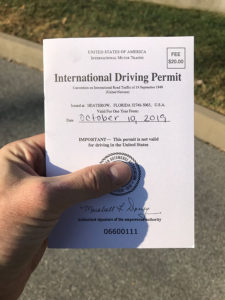
GET AN INTERNATIONAL DRIVERS LICENSE
It’s hard to climb and take public transportation to a crag. There are places, but crags are usually in protected areas away from town. To get an international drivers license in the United States, go to your local AAA office. At the time of publishing this, it costs about $30 (including the extra charge for the photo) for an international drivers license and it is good for a year. You can also post date the start of the license! For example, if you plan to climb a month from now, you can make the effective date start the day you arrive in another country and it would be good for a year from that date, not when you buy it. You do not need to take a test or anything. All you need to do is take a photo once you are there and complete a form. The license basically translations your real drivers license in a variety of languages. Not all countries require an international drivers license, but most do.
UNDERSTAND WHERE YOU CAN DRIVE YOUR RENTAL CAR
One of the biggest mistakes I see people make when driving in foreign counties is not knowing where they can and cannot drive their rental cars. For example, some rental car companies do not allow their cars to enter any other country. Other companies will give you a list of counties where the car is allowed. If you plan on crossing from Western to Eastern Europe, you will have to navigate the rules of each rental car company and its cars to find one that works for you. You will find many rental car companies ban you from entering counties like Bosnia and Herzegovina while others ban you from entering Italy!
One other thing to consider is the type of car you want and make sure it is allowed there. For example, since Italy has a lot of overly aggressive drivers, many rental companies will allow a car made by a Ford, Renault, or similar manufacturer into Italy, but not a BMW or a nice Sprinter van. In Iceland, there are roads that are restricted for certain cars. If you plan to climb at a crag down an “F” road in Iceland, you will need a car that is allowed on F roads. It takes time to research and read about the rules, but well worth it in the end. You don’t want to return a car to find a $1,000-fine because the GPS told them you were somewhere you should not have been.
I know renting a car in a foreign country scares a lot of people, but don’t let it discourage you! Once you read a few agreements, you can find the information fast! I find that rental agreements are generally easy to understand and translated into multiple languages. There are a couple companies that are vague and say things like they will tell you where you can and cannot drive once you get the car, but most are not like that. I obviously refuse to book with those companies!
KNOW YOUR RENTAL CAR AGREEMENT AND INSURANCE
Similar to knowing where you can drive is knowing the rest of the document and the laws. Some counties require rental car companies to include insurance with your rental, others do not. Even if the country requires the rental company to provide insurance, that company might still try to sell you on insurance that is already provided. One company “strongly” recommend I buy insurance, I told them it comes with it, and they said, ‘you read the information. Most people don’t know that!’
It sounds like a difficult challenge to understand the agreement before booking and it will take a couple minutes to read, but the agreements are usually very straight forward and it is well worth the knowledge in the end.
KNOW YOUR HEALTH INSURANCE AND WHAT IT COVERS
Healthcare laws vary greatly by country. Make sure you know if you are covered if you get sick or have an injury during your trip. If you do not have insurance, or are underinsured, you can buy travel health insurance for your trip and be covered.
It is also worth researching insurance coverage for being airlifted or evacuated out of an area.
PLAN YOUR LODGING
I usually prefer a mixture of four types of lodging for a climbing trip – camping, huts, hostels, and Airbnbs.
Backcountry camping isn’t allowed in many counties. Some allow it in higher elevations. Read the laws of the country and the area around the crag to see. If they do not allow it, there will usually be a campground nearby. A Google search will give you answers fast.
Staying in a hut before or after climbing is a great option. Having a warm place to sleep near a crag with someone to make breakfast saves a lot of time in the morning. It is much easier to get an alpine start without having to take down a tent, store it, make your own breakfast, and clean up. The innkeepers of huts near crags also have invaluable insights on climbing in the area. After climbing, the last thing most people want to do is hike out carrying a lot of gear. Staying a nearby hut gives you time to rest before leaving the area.
Hostels are a cheap and easy way to relax while meeting new friends and other climbers. If you stay near a crag, there will usually be climbers there with all the information you need from the trail to the route. The workers or owners of the hostel will also be knowledgeable about the climbing in the area. I start my search on Hostelworld.com to see what is available and the cost.
Airbnbs are a great place to relax and rest after a long climbing trip. They are more affordable than hotels and offer more amenities.
TALK WITH LOCALS WHEN YOU ARRIVE
Despite what I would call “decent” directions to a route from a variety of sources, I talked to a local near a crag in Italy and he gave me far superior directions. He told me things like, “at the end of the via ferrata, walk 20-meters and look for a cairn with only three rocks stacked on your right. Go up there!” That information was extremely valuable and saved a lot of time. The directions I had was basically, ‘look for the route on your right shortly after the end of the via ferrata.’ I would have walked past the cairn and would have been forced to backtrack to it later. It didn’t look like the way to the route at first glance, but was the only way.
DON’T PANIC AND START PLANNING!
I know, there are so many things to think about and a lot of moving parts. Don’t panic! This process should be easier that it appears. Once you know where you want to go, learn a few key words, find trusted information, read about the climbing area on official websites, and book your trip!
I am planning to visit North Macedonia sometime in the next year to climb. As of now, I do not know what crag I will climb at or what grades I will climb. The furthest I have explored is looking at the rock while flying over the country and downloading a drawn map showing where a few crags are scattered around the country. I do not know grades, trails, fees, or anything else about the crags. My friend asked about climbing there, so I have a partner to climb with. They received the recommendation from a stranger at a crag without real information like where or how. At this point, I have only completed two of the steps in this process. When I take the time to plan the trip, I will research the crags on Mountain Project and other websites, decide where and what I want to climb there, review laws on camping, find suitable camping locations and/or area hostels, huts, and Airbnbs, discover words I need to know in their Macedonian language, find the official website to confirm information I find other places, invite a couple other climbers, find access via public transportation or a rental car, and plan when and where to fly to. At this point, I assume I would fly to Thessaloniki in Greece if I climb in the southern part of North Macedonia and drive from there. If so, I would also climb in Greece. Can I can find a car cheap enough that will be allowed in North Macedonia and in the area around the crag? If not, I’ll look at train transportation from Thessaloniki to Skopje, North Macedonia. If I find a crag in the northern part of North Macedonia, I assume I would fly directly into Skopje. To get into either Thessaloniki to Skopje, I assume I would probably fly into cheap airports like Athens, Budapest, Paris, or Istanbul. Once I research and know where I want to go, I will review rental car agreements/terms, organize the rest of the trip, and create backup plans. In the end, I might not end up climbing the first crag I choose because of logistics. I might find access to other crags that are more suitable. The key to making it successful will be the research and being flexible with backup plans!
IF YOU HAVE QUESTIONS
If you would like recommendations, or have questions, send me a DM on Instagram or email me. Visit my Instagram at www.instagram.com/kevinflinttn or email Kevin (at) kevinflint.net anytime!


